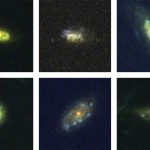W. M. Keck Observatory press release…
When astronomers add up all the gas and dust contained in ordinary galaxies like our own Milky Way, they stumble on a puzzle: There is not nearly enough matter for stars to be born at the rates that are observed. Part of the solution might be a recycling of matter on gigantic scales – veritable galactic fountains of matter flowing out and then back into galaxies over multi-billion-year timescales.
Now, a team of astronomers led by Kate Rubin of the Max Planck Institute for Astronomy in Germany has used the W. M. Keck Observatory to find evidence of just such fountains in distant spiral galaxies.
In the Milky Way, it’s estimated that every year about one solar mass (an amount of matter equal to that of our Sun) worth of dust and gas is turned into stars. Yet a survey of the available raw materials shows that our galaxy could not keep up this rate of star formation for longer than a couple of billion years. Star ages and comparisons with other spiral galaxies show that one solar mass per year is a typical star formation rate. So the puzzle appears to be universal.
This means additional matter must find its way into galaxies. One possible source is an inflow from huge low-density gas reservoirs filling the intergalactic voids. There is, however, little evidence that this is happening.
Another possibility, closer to home, involves a gigantic cosmic matter cycle. Gas is observed to flow away from many galaxies, and may be pushed by several different mechanisms, including violent supernova explosions (which are how massive stars end their lives), and the sheer pressure exerted by light emitted by bright stars on gas in their cosmic neighborhood.

Images of the six galaxies with detected inflows, detected by the Keck I telescope. Credit: NASA/STScI
As this gas drifts away, it is pulled back by the galaxy’s gravity, and could re-enter the same galaxy on timescales of one to several billion years. This process might solve the mystery. If so, then the gas we find inside galaxies may only be about half of the raw material that ends up as fuel for star formation. Large amounts of gas are caught in transit, but will re-enter the galaxy in due time. It’s a gigantic juggling act, in other words, with some of the balls in the galactic hands and others in the air. Added all together, there is a sufficient amount of raw matter to account for the observed rates of star formation.
Until now, however, there was a great deal of uncertainty about the idea of cosmic recycling. Would such gas indeed fall back, or would it more likely reach the galaxy’s escape velocity, flying ever further out into space, never to return? For local galaxies out to a few hundred million light-years in distance, there had been studies showing evidence for inflows of previously-expelled gas. But what about more distant galaxies, where outflows are known to be much more powerful? Would gravity still be sufficient to pull the gas back? If no, astronomers might be forced to radically rethink their models for how star formation is fueled on galactic scales.
To sort this out, Rubin and her team examined gas associated with a hundred galaxies at distances between 5 and 8 billion light-years with the Keck I telescope’s Low Resolution Imaging Spectrogtaph (LRIS). They found in six of those galaxies the first direct evidence that gas adrift in intergalactic space does indeed flow back into star-forming galaxies.
Even more encouraging, the inflow which can be detected by with the Keck I telescope might well depend on the angle at which we observe the galaxy. As Rubin and her team can only measure average gas motion, the real proportion of galaxies with this kind of inflow is likely to be higher than the six percent suggested by their data. It could, in fact, be as high as 40 percent. This is a key piece of the puzzle and important evidence that cosmic recycling could indeed solve the mystery of the missing star-making matter.
The results described in this release have been published as Kate H. R. Rubin et al., “The Direct Detection of Cool, Metal-Enriched Gas Accretion onto Galaxies at z ~ 0.5” in the journal Astrophysical Journal Letters, Vol. 747 (2012), p. 26ff. The co-authors are Kate H. R. Rubin (Max Planck Institute for Astronomy), J. Xavier Prochaska (MPIA and UCO/Lick Observatory, University of California), David C. Koo (UCO/Lick Observatory), and Andrew C. Phillip (UCO/Lick Observatory).

